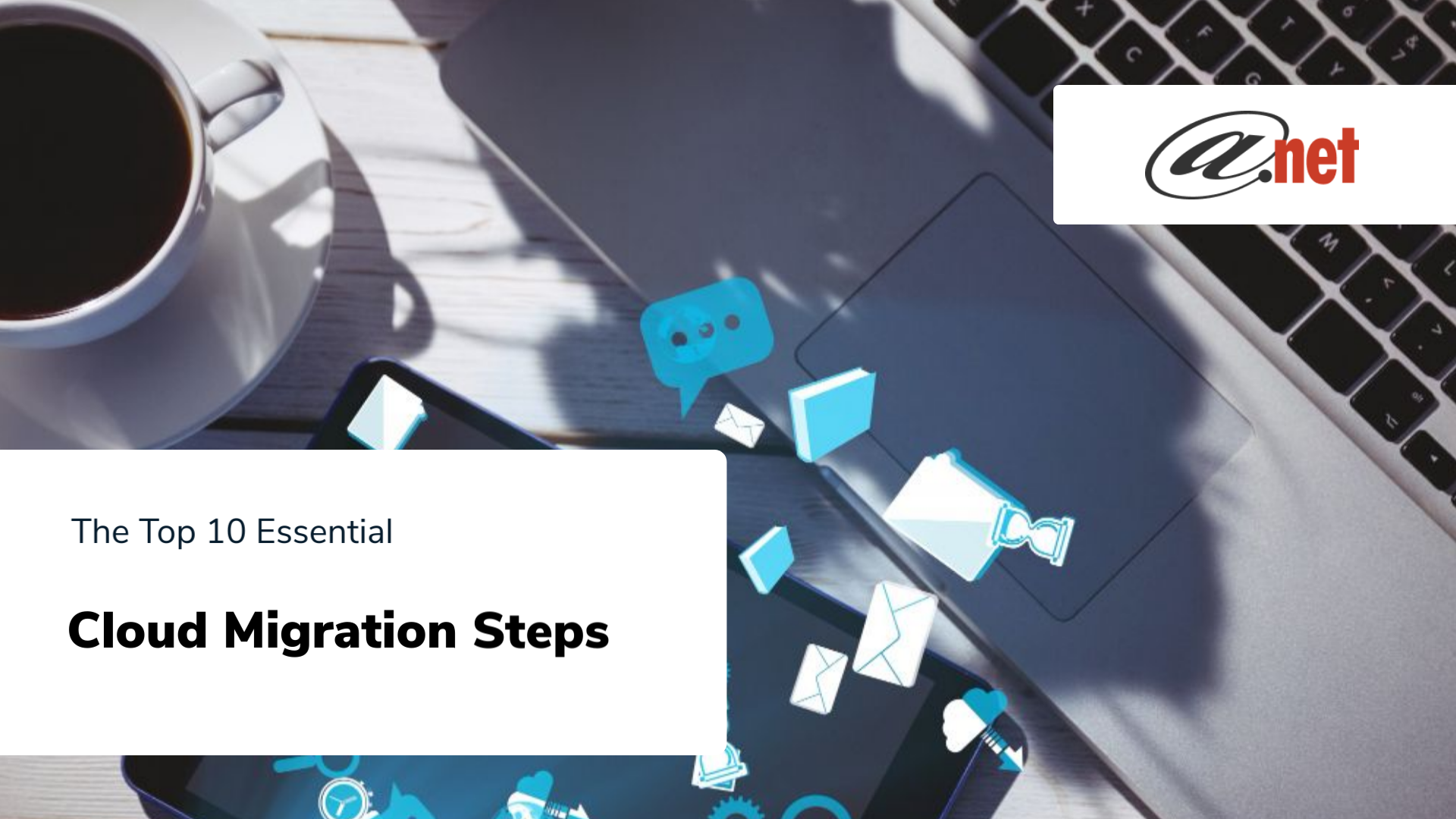
In an era where digital transformation is not just an advantage but a necessity, the move to the cloud has become a critical pivot point for businesses worldwide.
A staggering 63% of companies report that cloud migration has exponentially accelerated their scalability and operational efficiency. However, alongside this opportunity comes a suite of challenges.
| “In the rush to innovate, businesses often overlook the intricate dance of data migration.” ~Jeffrey S. King, President of AT-NET |
In this blog, we will break down the topic for you so you can make an informed decision about the steps you take in your cloud migration journey.
Step 1: Develop a Comprehensive Migration Strategy
Embarking on cloud migration without a strategy is akin to navigating uncharted waters without a map.
Before a single byte of data transitions to the cloud, it is crucial to craft a meticulous strategy. This blueprint is not just a schedule of IT tasks—it’s the articulation of your business’s vision in the context of cloud capabilities. It should detail your business objectives, outline the technical requirements necessary to achieve them, and establish clear metrics for success.
These metrics could range from cost savings and performance benchmarks to user adoption rates and system reliability standards.
Step 2: Assess Your Current IT Infrastructure
A comprehensive assessment of your current IT landscape is the bedrock of your cloud migration journey. This evaluation goes beyond a mere inventory check—it’s a critical appraisal of your applications, data repositories, and workloads with an eye for cloud compatibility and readiness.
During this phase, considerations such as which applications can be lifted and shifted versus those needing re-architecting for the cloud are made.
Get Expert Management for Your Cloud MigrationSee how having the right IT partner makes every difference! |
Step 3: Choose the Right Cloud Environment
Choosing between public, private, or hybrid cloud environments is a pivotal decision that hinges on your unique business requirements.
Each model offers distinct advantages and challenges. A public cloud provides scalability and flexibility at a potentially lower cost, while a private cloud offers enhanced security and control. A hybrid cloud marries the two, providing a balance of flexibility and security.
This decision will affect not only the initial migration costs but also the long-term operational expenses and compliance posture of your organization.
Step 4: Ensure Compliance and Security Measures
Transitioning to the cloud does not transfer the responsibility of data security and compliance to the cloud service provider alone.
While cloud providers typically offer robust security measures, it is imperative for your organization to understand the shared responsibility model and implement the necessary compliance controls and security protocols.
This entails meticulously reviewing the cloud provider’s security offerings and aligning them with industry regulations and company policies. Ensuring data protection, privacy, and compliance with relevant standards such as GDPR, HIPAA, or PCI-DSS remains a top priority throughout the migration process.
Step 5: Plan for Data Backup and Recovery
The importance of data backup and recovery cannot be overstated in the context of cloud migration.
Data is the lifeblood of modern businesses, and any loss can have significant repercussions. A robust backup strategy ensures that, in the event of a mishap during the migration process, data integrity is not compromised.
Recovery procedures are equally vital, providing a safety net that allows your business to regain operational capacity with minimal downtime quickly.
| Explore more cloud knowledge: |
Step 6: Optimize Applications for the Cloud
Moving to the cloud is an opportunity to not only relocate your digital assets but also to enhance them.
Cloud environments are rife with new capabilities and services that can optimize your applications for better performance, scalability, and resilience. However, to fully harness these advantages, some applications may require adjustments or complete re-architecting.
Optimization might involve refactoring for a more cloud-native approach, adopting microservices, or integrating with cloud-based analytics and AI services.
Step 7: Train Your Team for the Cloud
A successful migration is as much about technology as it is about people. As your infrastructure evolves, so must your team.
Training and change management programs are crucial investments to ensure that your staff is comfortable and proficient with the new cloud technologies. This education goes beyond mere operational training; it encompasses a cultural shift towards embracing the agility and innovation that the cloud enables.
Cloud Migration at a Glance:
| Step | Description | Key Considerations |
| Strategy Development | Plan the migration process. | Business goals, technical requirements, success metrics |
| IT Infrastructure Assessment | Evaluate current setup for readiness. | Application suitability, workload analysis, cloud compatibility |
| Choose Cloud Environment | Select public, private, or hybrid. | Cost, compliance, scalability, business needs |
| Compliance and Security | Implement security measures. | Data integrity, regulatory compliance, shared responsibility |
| Data Backup and Recovery | Ensure data safety. | Recovery strategies, backup frequency, data integrity |
| Optimize Applications | Adjust apps for cloud efficiency. | Performance, cloud features utilization, app re-architecting |
| Team Training | Educate staff on new technologies and manage change. | Skill development, change management, cultural adaptation |
| Execute the Migration | Move data and applications to the cloud. | Migration approach, business disruption minimization |
| Test Post-Migration | Validate functionality and performance in the cloud. | System operability, performance benchmarking, security checks |
| Continual Monitoring and Optimization | Regularly review and enhance cloud operations. | Performance metrics, cost management, ongoing improvements |
Step 8: Execute the Migration
The execution phase of cloud migration is a culmination of all the planning and preparation.
This pivotal moment can take various forms—a phased rollout, where applications and data are moved incrementally, or a full-scale migration for less complex environments. The chosen approach should reflect the strategic objectives, risk tolerance, and operational readiness of your organization.
Step 9: Test Post-Migration
After the migration, it’s not time to rest on your laurels—rigorous testing is essential. This phase validates that all systems and applications operate as expected in their new cloud environment.
It’s reported that 25% of businesses have seen performance improvements post-migration—a testament to the benefits of a well-executed cloud transition.
Testing should encompass performance benchmarks, security vulnerability assessments, and user acceptance to ensure that the migration has not only been successful technically but also has enhanced the overall user experience.
Step 10: Monitor and Optimize Continuously
The cloud migration journey doesn’t end once the data is in the cloud. Ongoing monitoring is vital to ensure that the cloud infrastructure is performing optimally and cost-effectively.
This continuous oversight involves tracking performance metrics, analyzing cost patterns, and seeking opportunities for further optimization. It’s about embracing the cloud’s dynamic nature—constantly adjusting and improving your cloud setup to align with evolving business needs and market trends.

Get Help with Your Cloud Migration Steps with AT-NET as Your Dedicated IT Partner
Your journey to the cloud, while complex, is a transformative one. AT-NET is here to navigate these waters with you.
| Discover these other locations for our managed IT services: |
For a seamless transition backed by expert knowledge and support, reach out for a free consultation to address your IT needs together.


